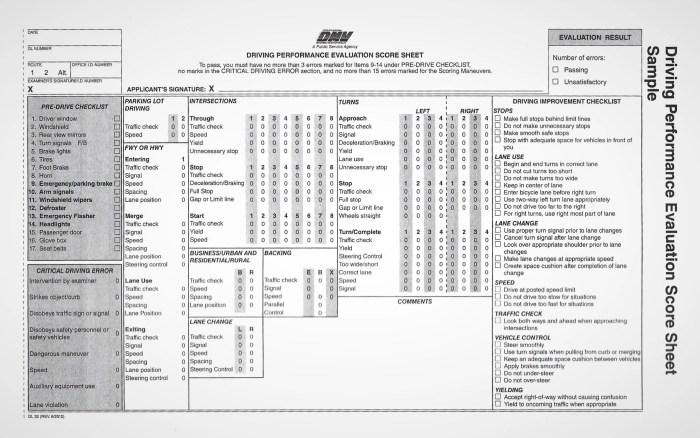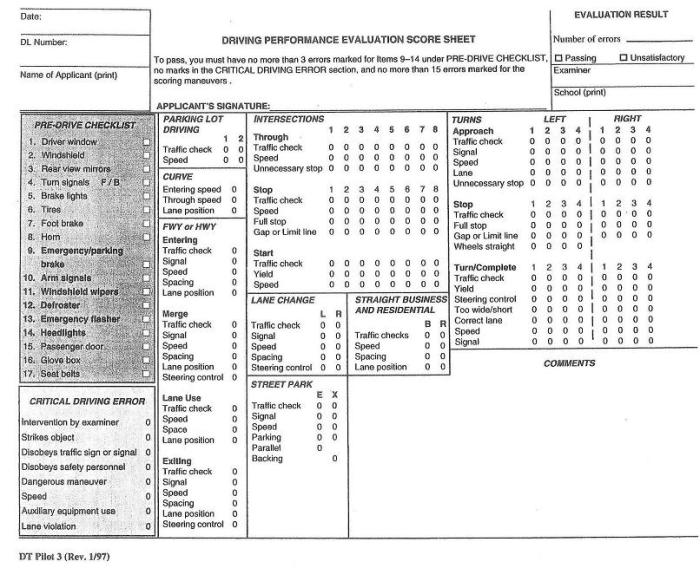Driving test score sheet wa abbreviations – Unveiling the significance of driving test score sheet abbreviations in Washington, this comprehensive guide embarks on an exploration of the intricacies of the state’s road test evaluation process. By deciphering the cryptic acronyms and understanding their implications, aspiring drivers can gain a competitive edge in their pursuit of a driver’s license.
The subsequent paragraphs delve into the scoring criteria, performance analysis, test preparation strategies, and frequently asked questions surrounding driving test score sheet abbreviations, providing a holistic understanding of this crucial aspect of the driving test experience.
Washington Driving Test Score Sheet Abbreviations

The Washington driving test score sheet is a comprehensive evaluation tool used to assess a driver’s performance during a road test. It provides a detailed record of the driver’s strengths and weaknesses, as well as specific areas where improvement is needed.
The score sheet is typically filled out by a certified driving examiner and includes a variety of abbreviations to indicate different aspects of the driver’s performance.
Scoring Criteria and Evaluation, Driving test score sheet wa abbreviations
The scoring criteria used to assess driving performance on the Washington driving test are based on a combination of objective and subjective measures. Objective measures include the driver’s ability to perform specific maneuvers, such as parallel parking and lane changes.
Subjective measures include the driver’s overall attitude, demeanor, and adherence to traffic laws.
The abbreviations on the score sheet correspond to specific driving maneuvers and skills. For example, the abbreviation “PP” indicates parallel parking, while the abbreviation “LC” indicates lane changes. Each maneuver is assigned a point value, and the driver’s total score is calculated by adding up the points earned for each maneuver.
Analysis of Performance
The abbreviations and scores on the driving test score sheet can be used to identify areas of strength and weakness in a driver’s performance. For example, a driver who scores poorly on the “PP” abbreviation may need to practice parallel parking.
Similarly, a driver who scores poorly on the “LC” abbreviation may need to improve their lane-changing skills.
The following table presents sample driving test score sheets with different sets of abbreviations:
| Maneuver | Abbreviation | Points Earned |
|---|---|---|
| Parallel Parking | PP | 10 |
| Lane Changes | LC | 8 |
| Turns | T | 9 |
| Intersections | I | 7 |
| Overall Attitude | OA | 9 |
By analyzing the abbreviations and scores on the score sheet, drivers can identify areas where they need to improve their driving skills.
Preparing for the Test
To prepare for the Washington driving test, drivers should familiarize themselves with the abbreviations and scoring criteria used on the score sheet. They should also practice the specific maneuvers that are included on the test. By understanding the abbreviations and scoring criteria, drivers can improve their chances of passing the test and becoming safe and responsible drivers.
FAQ Guide: Driving Test Score Sheet Wa Abbreviations
What is the purpose of the driving test score sheet?
The driving test score sheet serves as a standardized record of an individual’s performance during the road test, providing a detailed evaluation of their driving skills and adherence to traffic laws.
How can I prepare for the driving test score sheet abbreviations?
Familiarize yourself with the abbreviations by studying the official driver’s manual and practicing with mock tests that simulate the actual road test experience.
What are some common errors indicated by abbreviations on the score sheet?
Abbreviations such as “FS” (failed to stop), “SW” (speeding), and “FF” (followed too closely) often indicate critical errors that can impact the overall score and result in a failed test.

